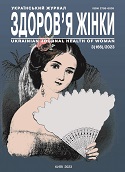The reproductive function of women with infertility after suffering COVID-19 infection
DOI:
https://doi.org/10.15574/HW.2023.166.4Keywords:
woman, reproductive function, COVID-19, long-COVID, infertility, assisted reproductive technologiesAbstract
The aim was to assess the status of reproductive function of infertile women after COVID-19 infection.
Materials and methods. The thorough examination included 120 patients who appealed to the reproductive clinic for infertility treatment. These women were divided into 2 groups: the main group - 80 women after COVID-19 infection (exclusion criteria - patients solely with the male factor of infertility), and the comparison group included 40 patients without COVID-19 infection in anamnesis.
Results. Patients with infertility and "long-COVID" have more pronounced disorders of the reproductive function compared to women without history of COVID-19 infection, namely: a decrease in the ovarian reserve (28.8% vs. 10.0%; p<0.05), various menstrual disorders (35.0% vs. 12.5%; p<0.05), including amenorrhea, irregular menstrual cycle and luteal phase insufficiency, high prevalence of genitourinary infections (37.5% vs. 17.5%; p<0.05). Against these disorders background, patients with "long-COVID" have significantly inferior results of in vitro fertilization programs: one in five has "poor ovarian response" (21.3% vs. 2.5%; p<0.05). Clinical pregnancy was diagnosed in 22.5% of patients versus 40.0% (p<0.05), and 2 women had a pregnancy loss in the 1st trimester, while all 16 women in the comparison group carried fetuses to live birth, i.e., the live birth rate was 20.0% versus 40.0% (p<0.05).
Conclusions. Determined changes in reproductive function may be directly or indirectly related to the "long-COVID" consequences, namely, a high level of stress, anxiety and depression, pernicious habits, general fatigability that leads to a sedentary lifestyle, sleep disturbances, the developing or exacerbation of somatic pathologies, among which stand out metabolic disorders and pathology of the liver and gastrointestinal tract.
This study was conducted in accordance with the principles of the Declaration of Helsinki. The research protocol was approved by the Local Ethics Committee of the abovementioned institution. Informed consents of the women were obtained for participation in this study.
The author declares no conflicts of interest.
References
American Academy of Pediatrics Committee on Adolescence, American College of Obstetricians and Gynecologists Committee on Adolescent Health Care, Diaz A, Laufer MR, Breech LL. (2006, Nov). Menstruation in girls and adolescents: using the menstrual cycle as a vital sign. Pediatrics. 118(5): 2245-2250. PMID: 17079600. https://doi.org/10.1542/peds.2006-2481; PMid:17079600
Baig AM. (2020). Deleterious Outcomes in Long-Hauler COVID-19: The Effects of SARS-CoV-2 on the CNS in Chronic COVID Syndrome. ACS chemical neuroscience. 11(24): 4017-4020. https://doi.org/10.1021/acschemneuro.0c00725; PMid:33275404
Dennis A, Wamil M, Alberts J, Oben J, Cuthbertson DJ, Wootton D et al. (2021). Multiorgan impairment in low-risk individuals with post-COVID-19 syndrome: a prospective, community-based study. BMJ open. 11(3): e048391. https://doi.org/10.1136/bmjopen-2020-048391; PMid:33785495 PMCid:PMC8727683
D'Ippolito S, Turchiano F, Vitagliano A, Scutiero G, Lanzone A, Scambia G, Greco P. (2022). Is There a Role for SARS-CoV-2/COVID-19 on the Female Reproductive System? Frontiers in physiology. 13: 845156. https://doi.org/10.3389/fphys.2022.845156; PMid:35309055 PMCid:PMC8924447
Halpin SJ, McIvor C, Whyatt G, Adams A, Harvey O, McLean L et al. (2021). Postdischarge symptoms and rehabilitation needs in survivors of COVID-19 infection: A cross-sectional evaluation. Journal of medical virology. 93(2): 1013-1022. https://doi.org/10.1002/jmv.26368; PMid:32729939
Hoida NG, Vdovichenko YuP, Moiseienko RA. (2017). Role of the legislative body of Ukraine in the monitoring of state healthcare programs. Health of woman. 2(118): 33-35. URL: http://nbuv.gov.ua/UJRN/Zdzh_2017_2_8.
Huang C, Huang L, Wang Y, Li X, Ren L, Gu X et al. (2021). 6-month consequences of COVID-19 in patients discharged from hospital: a cohort study. Lancet (London, England). 397(10270): 220-232. https://doi.org/10.1016/S0140-6736(20)32656-8; PMid:33428867
Kaminskyi V, Vorobei L, Zhdanovych O, Korniienko S, Kolomiichenko T, Fastovets О. (2022). Clinical and genetic determinants of severe course of COVID-19 in pregnant women. Reproductive endocrinology. (65): 38-43. https://doi.org/10.18370/2309-4117.2022.65.38-43
Kaminskyi V, Tkachenko R, Kaminskyi A, Zhdanovych O, Vorobei L, Kolomiichenko T et al. (2021). Therapeutic opportunities for improving the course of coronavirus disease and reducing the frequency of gestional complications. Reproductive endocrinology. (62): 8-13. https://doi.org/10.18370/2309-4117.2021.62.8-13
Mironyuk I, Slabkiy G, Shcherbinska О, Bilak-Lukianchuk V. (2022). Consequences of the war with the russian federation for the public health of Ukraine. Reproductive health of woman. (8): 26-31. https://doi.org/10.30841/2708-8731.8.2022.273291
Moreno-Pérez O, Merino E, Leon-Ramirez JM, Andres M, Ramos JM, Arenas-Jiménez J et al. (2021). Post-acute COVID-19 syndrome. Incidence and risk factors: A Mediterranean cohort study. The Journal of infection. 82(3): 378-383. https://doi.org/10.1016/j.jinf.2021.01.004; PMid:33450302 PMCid:PMC7802523
Nateghi R, Ghashghaei SH, Shokoohian B, Hezavehei M, Ebrahimi B, Shahverdi AH et al. (2021). Female Reproductive Health in SARS-CoV-2 Pandemic Era. International journal of fertility & sterility. 15(4): 241-245. https://doi.org/10.22074/IJFS.2021.534956.1164.
Transforming our world: the 2030 Agenda for Sustainable Development: draft resolution referred to the United Nations summit for the adoption of the post-2015 development agenda by the General Assembly at its 69th session. URL: https://digitallibrary.un.org/record/803352.
Downloads
Published
Issue
Section
License
Copyright (c) 2023 Ukrainian Journal Health of Woman

This work is licensed under a Creative Commons Attribution-NonCommercial 4.0 International License.
The policy of the Journal UKRAINIAN JOURNAL «HEALTH OF WOMAN» is compatible with the vast majority of funders' of open access and self-archiving policies. The journal provides immediate open access route being convinced that everyone – not only scientists - can benefit from research results, and publishes articles exclusively under open access distribution, with a Creative Commons Attribution-Noncommercial 4.0 international license (СС BY-NC).
Authors transfer the copyright to the Journal UKRAINIAN JOURNAL «HEALTH OF WOMAN» when the manuscript is accepted for publication. Authors declare that this manuscript has not been published nor is under simultaneous consideration for publication elsewhere. After publication, the articles become freely available on-line to the public.
Readers have the right to use, distribute, and reproduce articles in any medium, provided the articles and the journal are properly cited.
The use of published materials for commercial purposes is strongly prohibited.

